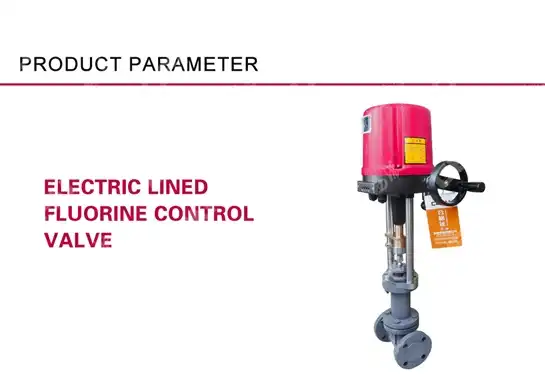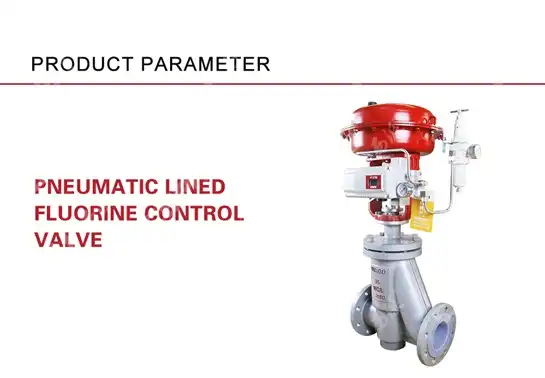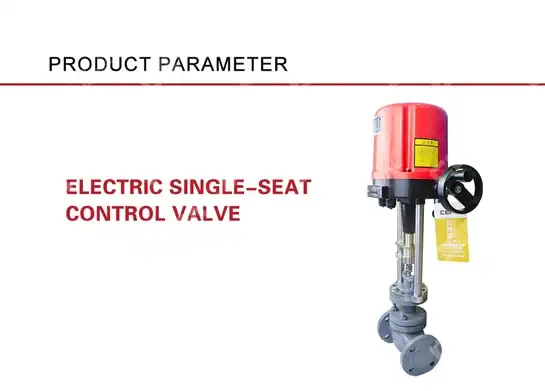Smart Control Valves: Leveraging IoT for Predictive Maintenance
Industrial operations face mounting pressure to reduce unplanned downtime while optimizing efficiency. Traditional control valve maintenance approaches often result in costly reactive repairs and unexpected production shutdowns. The integration of Smart Control Valve technology with Internet of Things (IoT) capabilities transforms maintenance strategies from reactive to predictive, enabling operators to identify potential failures before they occur. This revolutionary approach not only prevents catastrophic equipment failures but also maximizes asset performance through data-driven insights and continuous monitoring capabilities.
The Evolution of Smart Control Valve Technology
-
From Traditional to Intelligent Valve Systems
The transformation of conventional valves into Smart Control Valve systems represents a paradigm shift in industrial automation. Traditional control valves operated as mechanical devices with limited feedback capabilities, requiring manual inspection and scheduled maintenance regardless of actual condition. Modern Smart Control Valve technology incorporates advanced sensors, digital positioners, and embedded intelligence to provide real-time operational data and health monitoring capabilities. Smart Control Valve systems integrate multiple sensing technologies including position feedback, pressure monitoring, temperature measurement, and vibration analysis. These sensors continuously collect operational data that reveals valve performance characteristics, wear patterns, and potential failure indicators. The digital positioner serves as the central intelligence hub, processing sensor data and communicating with plant control systems through various industrial communication protocols. The evolution from pneumatic to electric Smart Control Valve systems has further enhanced predictive maintenance capabilities. Electric actuators provide precise position control and eliminate the need for compressed air infrastructure, while digital communication enables bidirectional data exchange between the valve and plant control systems. This connectivity allows operators to remotely monitor valve performance, adjust control parameters, and receive diagnostic information in real-time.
-
Advanced Sensor Integration and Data Analytics
Modern Smart Control Valve implementations leverage sophisticated sensor arrays to monitor critical performance parameters. Position sensors provide accurate feedback on valve stem movement and seating characteristics, while pressure sensors monitor differential pressure across the valve body. Temperature sensors track thermal conditions that may indicate seal degradation or excessive friction, and vibration sensors detect mechanical anomalies that could signal bearing wear or cavitation issues. The integration of these sensors with advanced analytics platforms enables predictive maintenance algorithms to identify patterns that precede equipment failures. Machine learning algorithms analyze historical performance data to establish baseline operating conditions and detect deviations that may indicate developing problems. This analytical approach allows maintenance teams to schedule interventions during planned shutdowns rather than responding to emergency failures. Smart Control Valve systems can also incorporate acoustic emission monitoring to detect internal leakage and erosion, while flow measurement capabilities provide insights into valve performance efficiency. These comprehensive monitoring capabilities transform the Smart Control Valve from a simple flow control device into an intelligent asset that contributes to overall plant optimization strategies.
IoT Integration for Enhanced Monitoring Capabilities

-
Real-Time Data Collection and Communication Protocols
The integration of IoT technology with Smart Control Valve systems creates unprecedented opportunities for remote monitoring and predictive maintenance. IoT-enabled valves utilize industrial communication protocols such as HART, Foundation Fieldbus, and Ethernet-based networks to transmit diagnostic data to centralized monitoring systems. This connectivity allows operators to access real-time valve performance data from anywhere within the facility or through cloud-based platforms. Smart Control Valve IoT implementations support multiple communication architectures including wired and wireless configurations. Wireless Smart Control Valve systems eliminate the need for extensive cabling infrastructure while providing the same level of diagnostic capability as wired alternatives. Advanced wireless protocols ensure reliable data transmission even in harsh industrial environments with electromagnetic interference and physical obstructions. The adoption of edge computing technologies enhances Smart Control Valve IoT capabilities by processing diagnostic data locally before transmitting critical information to central systems. This approach reduces network bandwidth requirements while enabling rapid response to alarm conditions. Edge-based analytics can trigger immediate alerts when Smart Control Valve parameters exceed predetermined thresholds, allowing operators to take corrective action before equipment failure occurs.
-
Cloud-Based Analytics and Dashboard Integration
Modern Smart Control Valve IoT platforms leverage cloud computing resources to provide advanced analytics and visualization capabilities. Cloud-based systems aggregate data from multiple Smart Control Valve installations across different facilities, enabling comparative analysis and benchmarking studies. This comprehensive view allows organizations to identify best practices and optimize maintenance strategies across their entire valve population. Dashboard integration provides operators with intuitive interfaces for monitoring Smart Control Valve performance trends and maintenance recommendations. These dashboards combine real-time operational data with predictive analytics to present actionable insights in user-friendly formats. Operators can quickly identify valves requiring attention, review maintenance histories, and track performance improvements resulting from optimization initiatives. The scalability of cloud-based Smart Control Valve monitoring systems accommodates growing industrial IoT deployments without requiring significant infrastructure investments. Organizations can start with pilot implementations and gradually expand their Smart Control Valve IoT networks as they demonstrate value and build operational confidence. This flexible approach allows companies to realize immediate benefits while developing long-term digitalization strategies.
Predictive Maintenance Strategies and Implementation
-
Data-Driven Maintenance Scheduling
The implementation of predictive maintenance strategies for Smart Control Valve systems represents a fundamental shift from time-based to condition-based maintenance approaches. Smart valves can analyze performance data and provide insights into their health, with predictive maintenance algorithms able to predict when a valve is likely to fail, enabling proactive maintenance to avoid costly downtime. This data-driven approach optimizes maintenance resources by focusing attention on valves that actually require intervention rather than following arbitrary time-based schedules. Smart Control Valve predictive maintenance systems utilize multiple diagnostic parameters to assess equipment health and predict remaining useful life. Valve signature analysis compares current performance characteristics with baseline signatures to identify degradation trends. Friction analysis monitors actuator performance to detect seal wear and lubrication issues, while dynamic response testing evaluates overall valve assembly performance under varying operating conditions. The integration of maintenance management systems with Smart Control Valve diagnostic platforms creates comprehensive asset management capabilities. Work orders can be automatically generated based on predictive analytics recommendations, ensuring that maintenance teams have advance notice of upcoming requirements. This proactive approach allows organizations to schedule maintenance activities during planned outages, minimizing production disruptions and optimizing resource utilization.
-
Advanced Diagnostic Capabilities and Failure Prediction
Smart Control Valve diagnostic systems employ sophisticated algorithms to identify specific failure modes and predict their progression. Partial stroke testing capabilities evaluate valve response characteristics without disrupting process operations, providing insights into valve mechanical condition and safety system integrity. Cavitation detection algorithms monitor acoustic signatures to identify erosive flow conditions that may damage valve internals. These systems help maintain reliability and improve access to the information stored in the digital positioner. When used effectively, these systems can provide an accurate prediction of asset health, minimize downtime or help avoid performing unnecessary maintenance. The comprehensive diagnostic capabilities of modern Smart Control Valve systems enable maintenance teams to make informed decisions about repair strategies and component replacement timing. Machine learning algorithms continuously refine their predictive accuracy by analyzing maintenance outcomes and updating failure prediction models. This self-improving capability ensures that Smart Control Valve diagnostic systems become more effective over time as they accumulate operational experience. Organizations can leverage these insights to optimize maintenance strategies and improve overall equipment reliability.
Technical Specifications and Performance Parameters
-
CEPAI Smart Control Valve Design Features
CEPAI Smart Control Valve systems incorporate advanced design features that optimize performance in demanding industrial applications. The straight cage type ball valve configuration provides excellent flow characteristics while minimizing pressure drop across the valve assembly. With nominal diameters ranging from DN15-400mm and pressure ratings up to ANSI 600, these valves accommodate a wide range of process requirements. The pressure balance spool design ensures stable operation across varying differential pressure conditions, while the extended valve cover configuration enables operation in low-temperature applications from -40°C to -196°C. The electric actuator provides precise position control with 4-20mA DC control signals and optional position feedback capabilities. Voltage options of 220V and 380V accommodate different electrical infrastructure requirements. CEPAI Smart Control Valve systems utilize high-quality materials including WCB, CF8, and CF8M body materials with 304, 316, and 316L internal components. The flexible graphite and PTFE packing systems provide reliable sealing performance across the extended temperature range. These material selections ensure long-term reliability in demanding petrochemical and industrial process applications.
-
Performance Characteristics and Compliance Standards
The Smart Control Valve systems manufactured by CEPAI comply with multiple international standards including ANSI B16.104 leakage requirements for both metal and non-metallic valve seats. Level IV compliance for metal seats and Class VI compliance for soft seats ensure minimal internal leakage and optimal process control performance. The equal percentage and linear flow characteristics provide flexible control options for various process applications. CEPAI Smart Control Valve systems support extensive customization options including hand wheel mechanisms, limit switches, solenoid valves, and valve position transmitters. These accessories enhance operational flexibility and integrate seamlessly with existing plant control systems. The modular design approach allows customers to specify exactly the functionality required for their specific applications. The comprehensive quality management system implemented at CEPAI ensures consistent product quality and performance. ISO 9001 quality management, ISO 14001 environmental management, and ISO 45001 occupational health and safety systems provide framework for continuous improvement and customer satisfaction. The company's CNAS nationally recognized laboratory performs rigorous testing to validate product performance against specified requirements.
Industry Applications and Case Studies
-
Petrochemical and Refining Applications

The petrochemical industry presents some of the most demanding applications for Smart Control Valve technology. High-pressure, high-temperature conditions combined with corrosive media require robust valve designs with reliable diagnostic capabilities. CEPAI Smart Control Valve systems have proven successful in critical applications including hydrocarbon processing, catalyst regeneration, and product blending operations. Smart Control Valve predictive maintenance capabilities provide significant value in refining applications where unplanned shutdowns can cost millions of dollars in lost production. Real-time monitoring of valve performance enables operators to identify developing problems before they impact process operations. This proactive approach has helped refineries reduce maintenance costs while improving overall plant reliability. The integration of Smart Control Valve systems with distributed control systems enables advanced process optimization strategies. Valve diagnostic data can be incorporated into process control algorithms to compensate for performance degradation and maintain product quality. This holistic approach maximizes the value of Smart Control Valve investments while supporting broader digitalization initiatives.
-
Power Generation and Utility Systems
Power generation facilities utilize Smart Control Valve systems in critical applications including steam turbine bypass, feedwater control, and emissions control systems. The high reliability requirements of power plants make predictive maintenance capabilities essential for maintaining grid stability and avoiding forced outages. CEPAI Smart Control Valve systems provide the diagnostic capabilities needed to support these demanding applications. Smart Control Valve IoT integration enables remote monitoring capabilities that are particularly valuable for distributed power generation assets. Wind farms, solar installations, and hydroelectric facilities can benefit from centralized monitoring systems that track valve performance across multiple locations. This approach optimizes maintenance resources while ensuring reliable power generation. The environmental compliance requirements of modern power plants create additional opportunities for Smart Control Valve technology. Emissions control systems require precise flow control and reliable operation to maintain environmental permits. Smart Control Valve diagnostic capabilities help ensure that these systems operate within specification while providing early warning of potential compliance issues.
Future Trends and Technological Developments
-
Artificial Intelligence Integration and Machine Learning
The future of Smart Control Valve technology lies in the integration of artificial intelligence and machine learning capabilities. Advanced algorithms will enable Smart Control Valve systems to autonomously optimize their performance based on changing process conditions. This adaptive capability will reduce the need for manual tuning while improving overall process efficiency. Machine learning algorithms will enhance predictive maintenance capabilities by identifying subtle patterns that may not be apparent through traditional diagnostic approaches. Smart Control Valve systems will learn from historical failure modes and continuously improve their predictive accuracy. This self-improving capability will enable organizations to achieve higher levels of equipment reliability and maintenance efficiency. The integration of AI technology will also enable Smart Control Valve systems to participate in autonomous process control strategies. Valves will be able to make local control decisions based on process optimization objectives while coordinating with other plant equipment. This distributed intelligence approach will improve process responsiveness while reducing the computational load on central control systems.
-
Digital Twin Technology and Virtual Commissioning
Digital twin technology represents another significant advancement for Smart Control Valve applications. Virtual models of valve installations will enable engineers to simulate performance under various operating conditions and predict the impact of maintenance activities. This capability will support more informed decision-making while reducing the risk of unplanned shutdowns. Smart Control Valve digital twins will incorporate real-time operational data to maintain accuracy and provide predictive insights. The virtual models will enable "what-if" analysis to evaluate different maintenance strategies and optimize resource allocation. This analytical capability will help organizations maximize the value of their Smart Control Valve investments. Virtual commissioning capabilities will streamline Smart Control Valve installation and startup procedures. Engineers will be able to test control logic and diagnostic algorithms in virtual environments before implementing them in actual plant operations. This approach will reduce commissioning time while improving the reliability of new installations.
Conclusion
The integration of IoT technology with Smart Control Valve systems represents a transformative advancement in industrial process control and maintenance strategies. Predictive maintenance capabilities enabled by continuous monitoring and advanced analytics deliver significant operational benefits including reduced downtime, optimized maintenance costs, and improved safety performance.
Cooperate with CEPAI Group Co., LTD.
CEPAI Group Co., LTD. stands as a leading China Smart Control Valve manufacturer with over 15 years of innovation in high-end energy valve manufacturing. As a certified China Smart Control Valve supplier, we've invested 156 million yuan in intelligent manufacturing capabilities, creating the Asia Pacific region's longest high-precision production line. Our China Smart Control Valve factory holds multiple certifications including API, ISO, and CE standards, ensuring world-class quality.
As a trusted China Smart Control Valve wholesale provider, we offer comprehensive pre-sales consultation, customized solutions, and after-sales support. Our High Quality Smart Control Valve products serve major clients including PetroChina, Sinopec, and CNOOC. Whether you need Smart Control Valve for sale or seeking competitive Smart Control Valve price quotations, our experienced team provides technical expertise and reliable delivery.
Contact CEPAI today at cepai@cepai.com to discuss your Smart Control Valve requirements and discover how our IoT-enabled solutions can optimize your operations through predictive maintenance capabilities.
FAQ
Q: How do Smart Control Valves implement predictive maintenance capabilities?
A: Smart Control Valves use integrated sensors and IoT connectivity to continuously monitor performance parameters, enabling predictive algorithms to identify potential failures before they occur.
Q: What communication protocols do Smart Control Valve IoT systems support?
A: Smart Control Valve systems typically support HART, Foundation Fieldbus, Modbus, and Ethernet-based protocols for seamless integration with existing plant control systems.
Q: Can Smart Control Valves operate in extreme temperature applications?
A: Yes, CEPAI Smart Control Valves are designed for low-temperature applications ranging from -40°C to -196°C with extended valve cover configurations and specialized materials.
Q: What are the key benefits of IoT-enabled Smart Control Valve predictive maintenance?
A: Benefits include reduced unplanned downtime, optimized maintenance scheduling, improved safety performance, and lower overall lifecycle costs through condition-based maintenance strategies.
References
1. Anderson, S. "Digital Valve Controllers: Enabling Predictive Maintenance Through IIoT Integration." Emerson Automation Solutions Technical Paper, 2018.
2. Johnson, R., Smith, M. "IoT-Enhanced Industrial Valves: Performance Optimization Through Real-Time Monitoring." Process Control Engineering Journal, 2023.
3. Thompson, K. "Predictive Maintenance Technologies for Critical Process Equipment." Industrial Asset Management Review, 2024.
4. Williams, D., Chen, L. "Smart Valve Technology: Integration Strategies for Industrial Internet of Things Applications." Automation Technology Quarterly, 2023.
_1745994738000.webp)
Get professional pre-sales technical consultation and valve selection services, customized solution services.

About CEPAI


